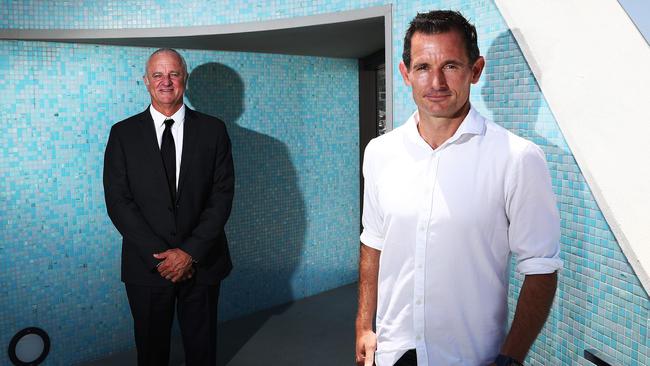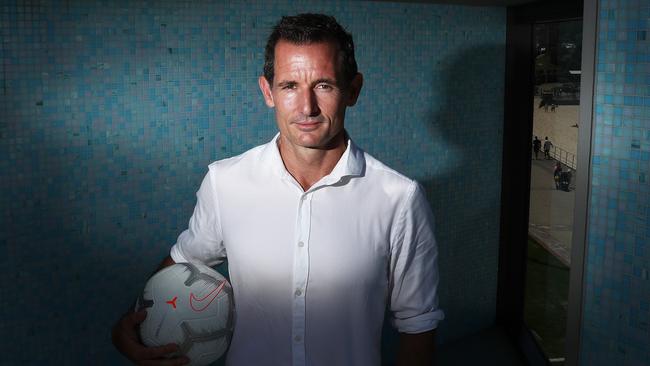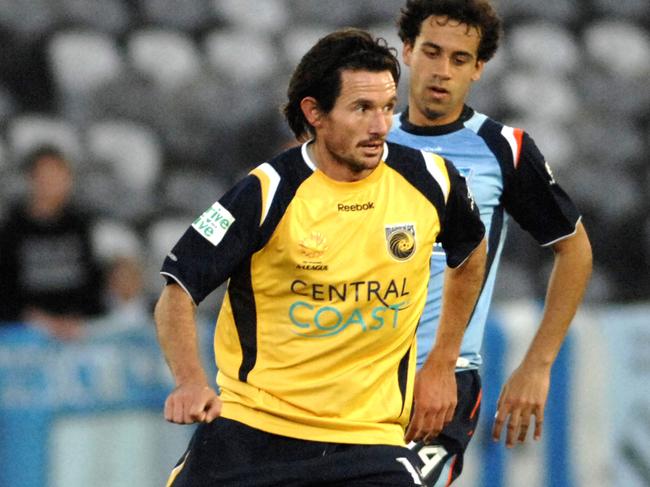The man behind the Socceroos’ meticulous fitness preparation
Getting the sports science spot on is a key focus of football operations across the world, and in Andrew Clark, the Socceroos have the right man for the job.
It’s no accident that the coaches of Australia’s last Asian Cup opponent and the next have both pointed out the superior fitness of their green-and-gold foes.
Syria lost their legs late in this week’s 3-2 loss to the Socceroos, who kept running all the way until Tom Rogic’s injury-time winner.
And on Thursday evening, when Uzbekistan was confirmed as Monday’s round-of-16 adversary, boss Hector Cuper described their ability to last the distance as an advantage needing eliminating.
Fitness has long been a national-team strength, and maybe never more so than now under the guidance of new sports science head Andrew Clark.
The former player turned strength and conditioning guru spent the past four years fuelling Sydney FC’s bottomless tank and keeping injuries at a striking low.
Now he’s helping the Socceroos join the global dots with players’ clubs, and in the long term hopes to streamline all Australian football under a single monitoring system to bring future stars to their physical peak.

Sports science has quickly become a major player in professional football, particularly in top leagues where even the slightest edge over a rival can make the difference.
Every successful moment on the pitch – a quick play forward, a reflex save – represents a meticulous behind-the-scenes operation of intensive assessments, charts and graphics.
It’s fine margins, just the way Clark likes them.
Of course, such minute detail is not always so sexy to fans of the finished product.
But in an age where Manchester City assigns personalised recovery drinks based on blood analysis and no training metre or moment is unaccounted for, it’s vital just to be in with a chance.
At the Asian Cup, the Socceroos’ sports science set-up is one of, if not the most advanced.
Little surprise given Australia’s standing as a world leader in the field, underscored in the way experts such as Darren Burgess are sought out by Liverpool and Arsenal, how current Socceroos high-performance coordinator Phil Coles has worked with the Reds and NBA side San Antonio Spurs, and how Clark’s predecessor Dr Craig Duncan is also in the United Arab Emirates helping tournament fancies Iran.

Clark followed head coach and long-time colleague Graham Arnold to the Socceroos in July with a view to transferring their record-breaking club achievements onto the international stage.
Six months later the 44-year-old reports he and other backroom staff, including long-standing team doctor Mark Jones, are making headway.
Particularly around transparency with players’ full-time employers.
“We’ve opened doors at the clubs of all the players where we’re now openly sharing information,” Clark tells The Saturday Telegraph.
“And we have clubs set up through STATSports, who provide our GPS, where we have an open sharing relationship.
“The only reason we want to do that is for the health and performance of the players, and I think the clubs realise that.
“What I’ve found is the clubs actually enjoy the fact that the player almost goes and has an external assessment when he’s with us and comes back with a report from a different set of eyes.

“Sometimes that can just add to the conversation of how we can improve the player. That all comes from trust, time and conversation and actually going to visit people and meeting face to face.
“Colesy has experience in Europe and has connections, emails a lot of people. I’ve done a lot in Asia so we’re connected and close with the people in those clubs. I think that’s how we can have our greatest impact.”
Coles’ links in particular helped with Hibernian helped in Martin Boyle’s recruitment, and it was he who travelled to Huddersfield for a second opinion of Aaron Mooy’s knee.
Last year Clark went to Japan to help the ahead-of-schedule recovery of Andrew Nabbout’s shoulder.
His other primary goal is domestic, and “much bigger than the Socceroos”.
“To unite Australian football under a single monitoring system,” Clark says.
“To get an understanding of what players are doing as they progress through the Australian system as far as testing athletic and football development.
“We’re a long way off that but we’ve started the process.”
Clark’s full-time foray into sports science occurred in 2010, at a time he remembers a scepticism around the philosophy of how it fits into the complex puzzle of football.
Because it’s all very well for a sprinter or a swimmer, or any sport where results are dominated purely by the physical.

In the round-ball game, if it’s not complementing the myriad other facets it can have a tendency to “float around the edges of a sport”.
“Football is tricky because success in the game is made up of people, parts, tactical, technical, physical,” Clark says.
“If sports science isn’t intertwined with the technical and tactical components of the game your improvement is not as strong as it could be.
“So we kind of had to re-set as an industry and have a deeper understanding of that to have an impact in the game.
“The most important thing is that the information from the sports science and sports medicine team needs to integrate with the coaching process, and the people within that team need to understand how we want to play the game. They can’t live in isolation.”
The other key to that symbiotism is the long-term relationship between Clark and Arnold.
The pair have worked side by for the eight years since he transitioned from professional player and part-time fitness coach at the Central Coast Mariners to fully fledged head of strength and conditioning.
Experiencing life as a player provided “a great teaching ground” that informs every decision he’s made since that first season in 2010-11 – Arnold’s first at the club.
“We had no relationship prior to that,” Clark says.

“So we sat down and had a coffee and he discussed his feelings about football, and they aligned pretty closely with how I felt about football.
“The relationship was new and we pushed on from there, just slowly built an understanding of what needed to be done to be successful.”
Two A-League championships, three premierships and an FFA Cup later over stints with Central Coast and Sydney FC sandwiching an ill-fated few months at J-League side Vegalta Sendai, the connection is borderline telepathic.
Often at the Sky Blues they’d rock up at the start of a week having separately planned all the same sessions.
“He gives me the trust to do what I need to and he doesn’t have to worry about any of that side of the business, he can just focus on what he does well,” he says.
“What he does really well is building relationships with players and clubs and extracting the best out of people.”
The Socceroos, though, is uncharted territory – at least for Clark.
“I’ve been in a club environment where I can take a player as a project and find out what they want, work out what they need to improve to achieve what they want, and then work on it for six or 12 months or two years.
“Then you have this transformation of someone over that period of time where they then go on and achieve their goals.
“In this environment you have to work out a new way to have the same sort of impact when you don’t have the day-to-day physical contact with a player.”
To make up for it, Clark and the team are in weekly contact with up to 100 players on the Socceroos and Olyroos extended squad list.
His day really begins in the evening when Europe wakes up, and there’s a constant stream of texts from players about everything from stretching to recovery boots.
Some he’s known since his Mariners days, like Rogic, Mat Ryan, Trent Sainsbury, Danny Vukovic and Mustafa Amini.
Others, such as Alex Gersbach, Matt Jurman and Rhyan Grant, he worked with at Sydney.
“Some I’ve coached from when they were kids,” Clark says.
“That first camp in Turkey was strange, walking in and seeing guys you haven’t seen since they were 18 or 19 years old and now they’re professionals in their late 20s in Europe.”
Strange, but also fortunate, because Clark knows their bodies well.
The mechanics of how they move, and what looks normal and what doesn’t to spot an injury before it’s happened.
With the rest it’s been watching and learning camp by camp, game by game, and while he’s leading training sessions alongside Arnold and Rene Muelensteen.
Helping the cause is video analyst Doug Kors – another Sky Blues recruit – who provides footage of club games.
Then it’s down to monitoring loads and ensuring players are physically capable of the demands set by, say, a certain style of football like Arnold’s mobile front three and the structure of a tournament like the Asian Cup.
The amount of technological advancement Clark has witnessed in recent years is “crazy”.
“But at the heart of technology has to be human communication, that’s where the strength lies,” he says.
“We need to get it right at the national-team level to show the junior national teams what we can do and make sure that’s unified, and then slowly from there branch out further and further into Australian football.”
Get every match of the 2018/19 Hyundai A-League LIVE. SIGN UP NOW!


